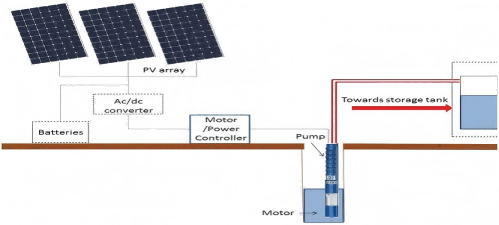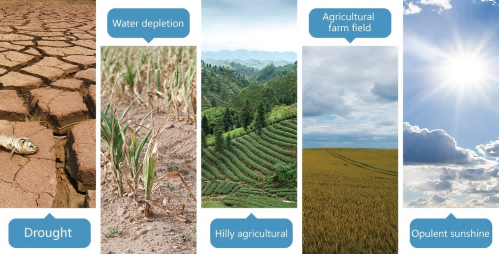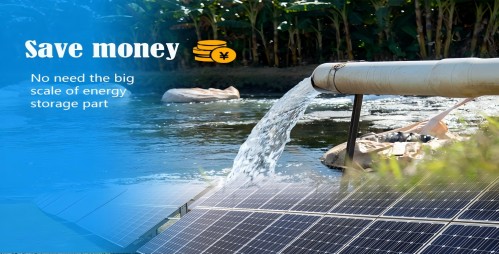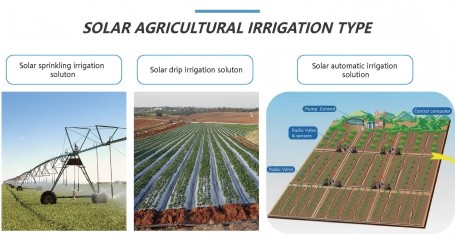The solar water pump system (solar water pumping system) drives the water pump from a low place to a high place by solar energy, mainly including four components: solar panel, photovoltaic bracket, AC pump, solar pump inverter. It can achieve normal pumping when the sun is full, and smooth access to the mains when the sun is insufficient or no sunlight to meet the normal pumping needs. Photovoltaic pump system is widely used in agricultural irrigation, domestic water supply, ecological water replenishment and other fields. Its revenue, prospects and application areas are analyzed as follows:

First, what is the core income of photovoltaic water pump system?
Economic gain
Low operating costs: Solar energy is free, no electricity costs, long-term savings in electricity or diesel costs (especially in high electricity prices or off-grid areas), can quickly recover costs
and continue to produce benefits.
Fast return on investment: In areas with sufficient light, the system payback period is usually 3-5 years, and the subsequent operation is almost zero cost.
Policy subsidies: Countries provide subsidies for renewable energy projects and subsidies and sponsorship for high-standard farmland projects (such as China's "photovoltaic poverty
alleviation", India's agricultural solar subsidies, etc.).
Environmental benefit
Zero carbon emissions: Replace diesel pumps, reduce greenhouse gases and air pollution, achieve a full range of photovoltaic utilization, there is sunlight to achieve irrigation, no sunlight
to stop working mode.
Sustainability: Renewable solar energy resources, reducing dependence on fossil energy.
Social benefit
To solve the problem of water shortage: to provide stable water sources for remote areas and arid areas, and to improve people's living and agricultural production conditions.
Improve agricultural efficiency: Precision irrigation improves crop yields and contributes to rural revitalization.
Where is application areas and scenarios?

Photovoltaic pump systems are suitable for the following typical areas:
1. Arid/semi-arid areas with abundant light resources
Typical areas: sub-Saharan Africa, the Middle East, Northwest China (such as Xinjiang, Gansu), India Rajasthan, South America and most other countries such as lack of electricity and water
areas.
Application scenario:
Agricultural irrigation: Solve the problem of water shortage in farmland in arid areas, such as photovoltaic drip irrigation system for cotton fields in Xinjiang, water use problems in Africa,
desert vegetation planting and so on.
Potable water supply: To provide domestic water for villages in desertified areas.
2. Remote and unconnected areas
Typical areas: rural Africa, mountainous South Asia (such as Nepal), the Andes Mountains of South America, etc.
Application scenario:
Off-grid water supply: Without grid support, direct use of solar water pumping, reducing infrastructure construction costs.
Water in pastoral areas: Provide drinking water for livestock of grassland herdsmen.
3. Islands and coastal areas
Typical areas: Southeast Asian islands (such as Indonesia, the Philippines), Mediterranean islands, etc.
Application scenario:
Fresh water supply: Pumping groundwater or desalting seawater to alleviate the shortage of fresh water on the island.
4. Ecologically fragile areas
Typical areas: China's Qinghai-Tibet Plateau, Africa's Sahel zone, etc.
Application scenario:
Ecological water replenishment: restore wetlands and grasslands to prevent desertification.

5. Cities and suburbs
Application scenario:
Landscape water: Circulating water systems in parks, golf courses and other areas.
Emergency water supply: as an urban backup water source system.
Third, development prospects
technology-driven
Photovoltaic efficiency: perovskite batteries, double-sided modules and other technologies to improve power generation efficiency.
Energy storage combination: With lithium batteries or gravity energy storage, to achieve stable water supply on rainy days.
Intelligent: Internet of Things (IoT) remote monitoring, AI optimization pump operation strategy.
Market demand growth
Agricultural modernization: The need for global food security drives the spread of water-saving irrigation technologies.
Carbon neutrality targets: National policies accelerate the phase-out of diesel pumps and the shift to clean energy.
Policy support
International assistance: The United Nations and the World Bank fund the promotion of photovoltaic pumps in developing countries (such as the African "Desert Energy Program").
Domestic subsidies: China's "rural revitalization" strategy and the EU's "Green New Deal" provide financial support.
Emerging market potential
Africa: More than 60% of agriculture depends on rainwater irrigation, photovoltaic pump coverage is less than 5%, and the market space is huge.
South Asia: India, Pakistan and other countries need to solve the electricity gap in agriculture.
Fourth, challenges and responses
High initial investment: reduce the burden of users through financial leasing and government subsidies.
Technical adaptation: The system needs to be customized according to the local light and water depth (such as high lift pumps for deep Wells).
Insufficient maintenance capacity: strengthen localization technology training and promote modular design.

Conclusion
Photovoltaic pump system has irreplaceable advantages in arid areas, no-grid areas, and ecologically fragile areas, and is one of the key technologies to solve the global water shortage and energy transformation. With technological progress and additional policies, its application scenarios will be further expanded, and it is expected to achieve large-scale popularization in developing countries and climate-sensitive areas in the next decade, becoming a "green engine" for agriculture, people's livelihood and ecological protection.

